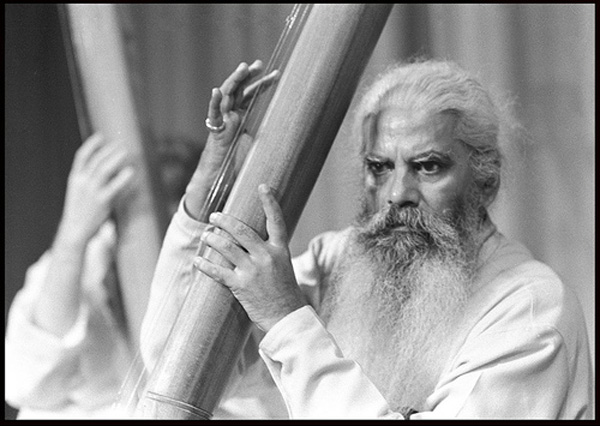Catherine Christer Hennix (b. 1948) started her creative career playing drums with her older brother Peter growing up in Sweden where she saw jazz luminaries such as John Coltrane, Eric Dolphy, Dexter Gordon, Archie Shepp, and Cecil Taylor perform at the Golden Circle. Directly after high school, Hennix went to work at Stockholm's pioneering Elektronmusikstudion (EMS), where she helped develop early synthesizer and tape music. After traveling to New York In 1968, she met Fluxus artists Dick Higgins and Alison Knowles and developed fruitful collaborative relationships with many composers in the burgeoning American avant-garde, including, most significantly, Henry Flynt and La Monte Young. Young introduced Hennix to Hindustani raga master Pandit Pran Nath, and she would later study intensively under him. While Hennix continued to make music performing alongside Arthur Russell, Marc Johnson, Henry Flynt, and Arthur Rhames, she also served as a professor of Mathematics and Computer Science at SUNY New Paltz and as a visiting Professor of Logic (at Marvin Minsky's invitation) at MIT's Artificial Intelligence Laboratory. In recent years Hennix has led the just-intonation ensemble the Chora(s)san Time-Court Mirage. She currently resides in Berlin, Germany, where she is active as a composer and writer.

|
|
|
|
|
|
|
|
|
|
|
|
CD
|
|
IMPREC 398CD
|
2021 restock. Central Palace Music, performed by Catherine Christer Hennix's just-intonation ensemble The Deontic Miracle, is the first in a series of archival Hennix releases to be issued via Important Records. This previously unheard piece was taken from an eight-day festival organized in the spring of 1976 at the Museum of Modern Art in Stockholm. The group features Catherine Christer Hennix on Renaissance oboe and custom sinewave generators, Peter Hennix on Renaissance oboe, and Hans Isgren on sheng. Central Palace Music is packaged in a deluxe letterpressed sleeve.
"She has created a sound that reliably taps into our subconscious and frees us from linear time" --The Quietus. Catherine Christer Hennix (born 1948 in Stockholm) is an artist, poet, composer, and philosopher with a strong interest in logic and formal music theory. In late-1960s Sweden, she was a pioneer of experimenting with mainframe computer-generated composite soundwave forms, and in the 1970s she was a key protagonist of the Downtown School along with La Monte Young and Henry Flynt, with whom she has collaborated on numerous occasions. She pursued studies with master vocalist Pandit Pran Nath and led the just-intonation live electronic ensembles Hilbert Hotel and The Deontic Miracle (featured on this recording). She was a professor of mathematics and computer science and assistant to and coauthor with A. S. Esenin-Volpin, for which she received the Centenary Prize-fellow Award from the Clay Mathematics Institute in 2000. Hennix's interest in drone music and the meditative, trance-like state it induces is apparent in her exploration of similar music in many other cultures and traditions, including, for example, Japanese gagaku music and the 13th-century vocal music of Pérotin and Léonin.
|
|
|
Artist |
Title |
Format |
Label |
Catalog # |
|
|
CD
|
|
IMPREC 434CD
|
Restocked. Live At Issue Project Room is the first recording of the expanded configuration of Catherine Christer Hennix's Chora(s)san Time-Court Mirage just-intonation ensemble, documenting a 2014 performance at Issue Project Room. The ensemble of Hennix (voice) and Hilary Jeffery and Robin Hayward (brass) is expanded to include vocalists Imam Ahmet Muhsin Tüzer, Amir Elsaffan, and Amirtha Kidambi; brass players Paul Schwingenschlögl and Elena Kakaliagou; and Marcus Pal and Stefan Tiedje on electronics. Live At Issue Project Room is packaged in a deluxe letterpressed sleeve.
"She has created a sound that reliably taps into our subconscious and frees us from linear time" --The Quietus. Catherine Christer Hennix (born 1948 in Stockholm) is an artist, poet, composer, and philosopher with a strong interest in logic and formal music theory. In late-1960s Sweden, she was a pioneer of experimenting with mainframe computer-generated composite soundwave forms, and in the 1970s she was a key protagonist of the Downtown School along with La Monte Young and Henry Flynt, with whom she has collaborated on numerous occasions. She pursued studies with master vocalist Pandit Pran Nath and led the just-intonation live electronic ensembles Hilbert Hotel and The Deontic Miracle. Hennix's interest in drone music and the meditative, trance-like state it induces is apparent in her exploration of similar music in many other cultures and traditions, including, for example, Japanese gagaku music and the 13th-century vocal music of Pérotin and Léonin. In 2003 she returned to computer-generated composite soundwave forms or "soliton(e)s," of which Infinitary Composite Sound Wave Form Composition Soliton(e) Star (2003-present) was the first result. She subsequently formed the Choras(s)an Time-Court Mirage just-intonation ensemble; in 2012, Important Records released a performance by this ensemble of "Blues Dhikr Al-Salam (Blues Al Maqam)" as Live At The Grimm Museum Volume One (IMPREC 354CD). In 2012 Henry Flynt asked Hennix for a new, expanded realization of an "Illuminatory Sound Environment" for an installation at the ZKM in Karlsruhe, Germany, for his "Henry Flynt. Activities 1959 --" exhibition. In response Hennix realized a four-channel composition, Rag Infinity/Rag Cosmosis, her first four-channel computer-assisted composition since 1969.
|
|
|
Artist |
Title |
Format |
Label |
Catalog # |
|
|
CD
|
|
IMPREC 354CD
|
2013 repress. "Blues Dhikr Al-Salam (Blues Al Maqam) for voice, brass, computer and live electronics in the mixed-media environment Nur/Soliton(E) Star. The world premiere of the infinitary computer animation NUR and the accompanying infinitary computer sound composition Soliton(E) Star were given at Diapason Gallery (NYC) for the celebration of La Monte Young's 70th birthday in 2005. Catherine Christer Hennix has now extended this installation in the venerable tradition of the pentatonic blues for a live-electronic ensemble. Recorded live on Sunday August 14, 2011 at the Grimm Museum, Berlin."
|
|
|
|